Graham Reid | | 4 min read

When the explorer and entrepreneur James Brooke sailed up the Sarawak River in northern Borneo in 1838, he encountered a small village of local people and, if we believe the legend, an unnaturally large number of short-tailed cats.
At this point in our story the cats become more important than the people, because the village – which grew into a city of half a million people today – was given the name Kuching, which means cat city. And the people of Kuching take their cats – which roam freely through bars, cafes, shops and open-air restaurants – very seriously.
At a few key intersections there are statues of cats (some rather unattractive it has to be said), and the city boasts the famous Cat Museum filled with anything and everything relating to cats, or even just – as the movie posters of Cat on a Hot Tin Roof and Cat Ballou attest – a mere mention of the animal.
The museum inside the massive Kuching North City Hall about 15 minutes from the city centre is one of the more mad attractions (or cute, depending on how you feel about felines) in this easy-going city which has a smalltown ambience.
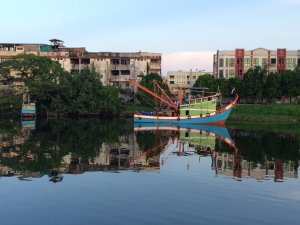 That's in part due to the walkway
running alongside the river where, at night, hawkers open their
tents, musicians play and small cafes and eateries pop up selling
excellent and ridiculously cheap food and drinks.
That's in part due to the walkway
running alongside the river where, at night, hawkers open their
tents, musicians play and small cafes and eateries pop up selling
excellent and ridiculously cheap food and drinks.
The illuminated riverwalk is one of the focal points of this predominantly Muslim city which has a fascinating cultural mix of Malay, Chinese and Indian, and a unique history. James Brooke became the first “white Rajah” in the region and the Brooke family palace, or Astana, is just across the river beside the impressive parliament building.
I first visited Kuching five years ago and promised myself I'd return. I barely scraped the surface because its relaxed feel – which saw me in the James Brooke Bistro and Cafe near the river a few times for cool beers in the humidity – made my time there more a holiday than an exploration.
So when the chance came up to attend the annual Rainforest World Music Festival about 40 minutes away – like a Womad but with more Malaysian and Indonesian artists – I grabbed the opportunity and happily got back to Kuching.
As a city it is easy to walk around. It is flat, the central area readily accessible, and if you have to watch the footpaths in places – small steps up and down to channel water during tropical rainstorms – you get used to that quickly. The central area takes in half a dozen streets and lanes back from the river between one cat statue to the east and the open-air market a 10 minute walk to the west, and near the enormous mosque.
 There is a conveniently central museum
district which is highly recommended for the insights it gives into
the history of the region. The main Sarawak Museum – in two parts
linked by a bridge across a main thoroughfare – is an essential
stop-off. It is crammed with stuffed examples of the rich wildlife of
the region. And if you can't make it to an Iban longhouse to see how
those people live, the museum has some decent replicas . . .
although they are rather more clean and less smelly than the one I
stayed in.
There is a conveniently central museum
district which is highly recommended for the insights it gives into
the history of the region. The main Sarawak Museum – in two parts
linked by a bridge across a main thoroughfare – is an essential
stop-off. It is crammed with stuffed examples of the rich wildlife of
the region. And if you can't make it to an Iban longhouse to see how
those people live, the museum has some decent replicas . . .
although they are rather more clean and less smelly than the one I
stayed in.
Make sure you look up when you see the wall of photos and information about how the Iban used to be headhunters.
The nearby Textile Museum is fascinating too, although you wouldn't want to be locked in there overnight if the mannequins came alive. Some of those women look very unhappy in their work and a few have extremely deranged expressions. Worth a look even if beautiful handmade textiles are not your thing.
A must-see however is the Islamic Museum which contains a breathtaking scale model of the State Mosque of Sarawak which can hold 8000 in the main hall alone. Muslims arrived in this region many centuries ago and the museum contains a stone discovered in 1902 after a flood which – in Arabic writing but in the Malay language – cites some extremely severe Islamic laws and the punishments for transgressors. It is believed to be from the mid 15th century.
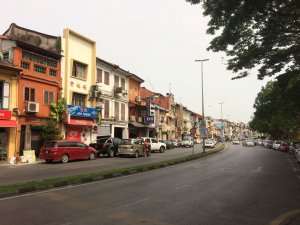 There are rooms containing menacing
weaponry, gorgeous decorative arts such as intricately carved wooden
boxes, various handwritten copies of the Quran in that beautifully
mysterious script (one so small it fits in the palm, another so large
it would take two people to lift), models and photos of impressive
Islamic architecture, costumes . . .
There are rooms containing menacing
weaponry, gorgeous decorative arts such as intricately carved wooden
boxes, various handwritten copies of the Quran in that beautifully
mysterious script (one so small it fits in the palm, another so large
it would take two people to lift), models and photos of impressive
Islamic architecture, costumes . . .
It's something to see, and mercifully cool on a humid day.
The Chinese Museum near the river – and beside the Brooke Bistro – is in an old Chinese court building established by Charles Brooke (James' nephew who inherited the Rajah title). It may be small but it economically outlines the waves of Chinese migrants – mostly miners and farmers before the shopkeepers came – who have made this area their home, bringing with them over a dozen dialects.
But we cannot live by culture alone, and within walking distance of these places are sophisticated malls, the shops along India Street crammed with everything from electronic goods to colourful fabrics, cat-kitsch souvenir shops and more cheap eating places than you can imagine.
How cheap? A plate of roast duck with soup and rice, plus two iced teas at an open-air (and admittedly run-down) Chinese place clocked in around $4. Beer is about $3 a bottle, freshly-squeezed sugared lime juice with ice along the riverwalk around $1.
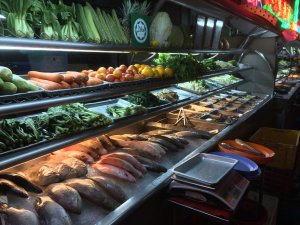 No one could go to Kuching and not
visit Top Spot, an open-air seafood place which is a magnet for local
families and tourists alike. I'd put up serious money and bet you've
never seen this much fresh seafood diversity anywhere.
No one could go to Kuching and not
visit Top Spot, an open-air seafood place which is a magnet for local
families and tourists alike. I'd put up serious money and bet you've
never seen this much fresh seafood diversity anywhere.
There are a dozen or more very large places with their ice trays displaying crab, banana prawns the size of which live up to the description, fat squid, plump shrimps, sea cucumber, so many varieties of fish you couldn't count . . .
If ocean-fresh seafood means anything to you, Top Spot will be a highpoint of your time in Kuching, the cat city of the banks of the Sarawak River.
Or get yourself to nearby Buntal.
With these many attractions, its proximity to Bako National Park which has exotic wildlife including proboscis monkeys, nearby beaches and the orang-utan reserves, Kuching is worth discovering in Malaysian Borneo.
Cats, which in both Malay and Chinese culture are associated with luck, have certainly brought good fortune to the delightful, interesting and unique city – or small town, as I think of it – that is Kuching.

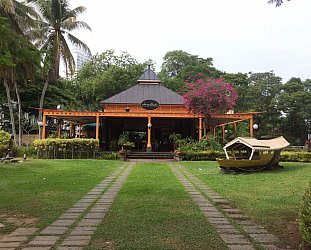
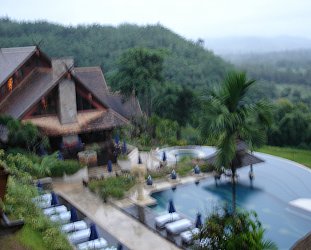

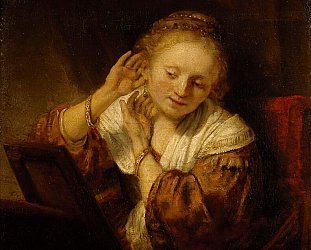
post a comment